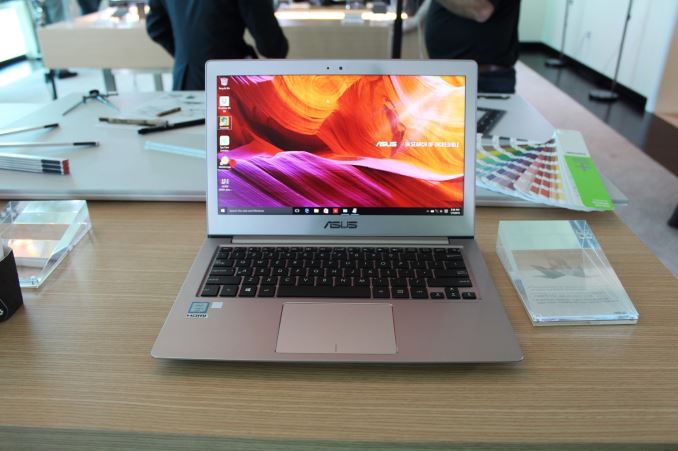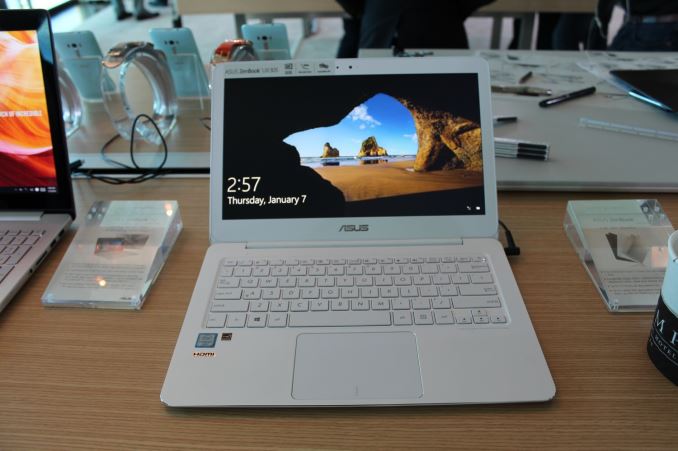ASUS Booth Tour at CES 2016: 10G Switches, External GPU Dock, USB-C Monitor and more
by Ian Cutress on January 19, 2016 9:00 AM ESTLaptops Laptops Laptops Laptops
Section by Brett Howse
ASUS didn’t have any really new laptops for CES, but we did get a chance to check out some that had been announced over the last couple of months with the launch of Skylake. The 15.6-inch ZenBook Pro is arguably ASUS’s flagship laptop, with a full aluminum chassis and 45-Watt Skylake CPUs. It also features an NVIDIA GTX 960M GPU, and PCIe storage. Optionally there is a UHD display with 100% Adobe RGB color space coverage. It’s a great looking laptop, and plenty powerful as well.
Moving down in price and performance is the UX303UA, which is a 13.3-inch Ultrabook with U series Skylake processors. It’s fairly light and thin, and is an incremental upgrade over the previous model. ASUS also had the UX305CA, which is the Skylake powered version of the UX305 that we reviewed in 2015, and ASUS sent us the new Skylake model to put through its paces so look for a review of this soon. The UX305 was one of our recommended Ultrabooks of 2015, as it offers more bang-for-buck at 8 GB of memory and 256 GB of SSD storage for just $699.
UX303UA
UX305CA
On the ROG side of things, I (Ian) saw the ROG GX700 laptop with the external water cooling graphics dock for the first time. Actually seeing the device (and how heavy it is), I finally understood the concept which didn’t come across that obvious before. The unit is a fully sealed graphics card and water loop, almost like a dock, which attaches firmly in place to the laptop and can’t be removed in use. When connected, it uses PCIe to interface between the CPU and GPU, much like other solutions such as the GS30.
What was perfectly clear is that this arrangement doesn’t come cheap. The laptop itself is a hefty number as well, making it less mobile than expected.














50 Comments
View All Comments
WhisperingEye - Wednesday, January 20, 2016 - link
Panzerknacker- I don't understand why you replied to a phone question with a router question.Xajel - Sunday, January 24, 2016 - link
The main reason behind this is that most consumer devices hardly sustain the 1Gb connection.. only some extreme consumers like heavy media servers at home that serves multi 4K stream...so for a consumer, 1Gb is enough, and there's no devices that can make use of 10Gb for the consumer...
Some advanced/enthusiast users uses a Link Aggregation connection as a backbone of their network ( NAS -> Switch <- HTPC/Main PC ) so these can serve multi streams in the same time without any drops... but that is rare as 1Gb is enough for most users already...
Maybe pro users, like pro video editing needs these 10Gb links, but it's already rare situation to see this in a home user, a person with the need for 10Gb ethernet is already using high-end workstations with professional systems.. so it's not a consumer oriented product any more...
Personally I thought about having 10Gb as a backbone for my home network just to be future proof.. but after looking again.. I found it too expensive, and I can make 2x 1Gb Link Aggregation which much less cost and still serve me well for few years a head ( NAS + HTPC + router + Switch all with LA connections )
Lieuchikaka - Thursday, June 2, 2016 - link
http://mavangvn.vn/ma-vang-dien-thoai/dien-thoai-s...Lieuchikaka - Thursday, June 2, 2016 - link
http://mavangvn.vn/ma-vang-dien-thoai/dien-thoai-s...rhx123 - Tuesday, January 19, 2016 - link
Using their own standard instead of TB3 just screams of Vendor Lock-In, especially when TB3 can do 36gbps over an active cable.SirKnobsworth - Tuesday, January 19, 2016 - link
According to Tom's, they actually require 2 type C cables too.Alexvrb - Tuesday, January 19, 2016 - link
Your statement is ironic to me because thunderbolt is itself... a proprietary standard. For external graphics we really need a standardized "Type G" port or something that can provide all the bandwidth by itself. But that will probably never happen. For that matter, even a much tamer enclosure hosting "only" up to 150W GPUs would still be a huge boost for a laptop.nathanddrews - Tuesday, January 19, 2016 - link
So... what are the implications of USB-C displacing HDMI and DisplayPort connectors? I know that it technically is DP over alternate mode, but it's clearly very popular. It seems like many new displays have it built in. Adaptive Sync? Latency? Would there be a penalty of some kind for sending video output through the USB bus instead of directly from the GPU?My only experience is with a first-generation USB display that sucked immense balls.
SirKnobsworth - Tuesday, January 19, 2016 - link
It's just a multiplexer that sends the signal over unused pins. You only get two lanes (as opposed to the usual 4), but that's fine as long as you don't need 4k60.Ryan Smith - Tuesday, January 19, 2016 - link
You can get 4 lanes of DP. It just uses up all the differential pairs, so you have to give up USB 3.x to get it (which is why DP 1.3 is going to be such a big deal).